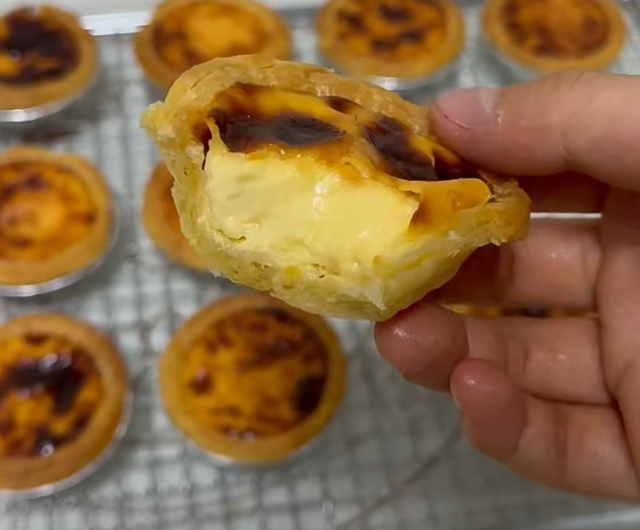Homemade Portuguese Custard Tarts
Homemade Portuguese Custard Tarts! Step-by-step guide with super detailed instructions! The crust is crispy and flaky, and the custard filling is smooth and creamy! Once you learn how to make these, you’ll never need to buy them again!

 1 Comments
1 Comments
What are Portuguese Custard Tarts?
Portuguese Custard Tarts, or Pastéis de Nata, are a classic dessert from Portugal. The pastry crust is made from flaky, buttery puff pastry, which bakes up golden and crispy, making a satisfying “crunch” when you bite into it.
The filling is made from eggs, cream, and sugar, resulting in a silky, custardy texture similar to pudding. When baked just right, the perfect balance of creamy sweetness and caramelized flavor emerges.
These tarts have become popular worldwide, especially after being adapted in Macau, where they’ve gained even more fame and are commonly found in bakeries everywhere.

Ingredients Needed
Egg Tart Shells: The base of the egg tart, these crispy shells perfectly complement the smooth, creamy custard filling. Pre-made egg tart shells are convenient and quick to use, but if you have the time and interest, you can also make your own.
Eggs: A key ingredient in the custard, eggs help the filling set and contribute to its rich, eggy flavor, adding to the overall taste and nutritional value of the tart.
Light Cream: Adds a rich, creamy flavor and smooth texture to the custard, making it more decadent and velvety.
Whole Milk: Provides moisture and a mild dairy flavor to the custard, making the filling lighter and smoother.
White Sugar: The main source of sweetness in the custard, giving the tarts just the right amount of sweetness. It also helps the custard brown slightly during baking, giving the tarts a beautiful golden finish.
Common Mistakes to Avoid
Uneven Mixing:
If the egg tart filling isn’t mixed thoroughly, the sugar may not fully dissolve, and the cream and milk may not blend properly. This can result in uneven flavor in the tarts and may even cause separation or layers to form during baking.
Skipping the Straining Step:
If the custard isn’t strained after mixing, any bubbles or undissolved particles will remain in the filling. When baked, this can cause the surface of the tarts to be dotted with small holes, which affects both the appearance and texture, making it less smooth and creamy.
Improper Oven Preheating:
If the oven isn’t preheated sufficiently, or the temperature hasn’t reached 200°C (400°F) before placing the tarts inside, the custard will not bake evenly. This can result in a soggy crust and an undercooked filling, affecting the overall texture and appearance of the tarts.
Overfilling the Tart Shells:
When filling the tart shells, don’t overfill them. If the custard spills over during baking, it can create a mess and cause the tarts to lose their shape. It’s best to fill the tart shells about ¾ full for optimal results.
INGREDIENTS
MAIN INGREDIENTS
- 6-10 tart shells
- 2 eggs
ACCESSORIES
- 165g light cream
- 90g whole milk
- 35g white sugar
DIRECTIONS
STEP 1
First, remove the tart shells from the freezer and allow them to thaw.

STEP 2
In a bowl, combine 2 eggs, 35g white sugar, 165g light cream, and 90g whole milk.

STEP 3
Whisk the mixture until well combined.

STEP 4
Strain the mixture to ensure a smooth custard.

STEP 5
Pour the prepared custard into the tart shells.

STEP 6
Place the tarts in a preheated oven (preheat to 200°C / 400°F for 10 minutes).
Bake at 200°C (400°F) for 25 minutes, with both top and bottom heat.

STEP 7
The Portuguese custard tarts are ready and filled with a wonderful fragrance throughout your home!

More Recipes Worth Trying
Strawberry cream ice cream recipe
How to Reheat Custard Tarts?
Portuguese custard tarts are best enjoyed fresh on the day they're made and should be consumed within 24 hours at room temperature.
To reheat these Portuguese custard tarts, preheat your oven or toaster oven to 350°F and heat for 7-10 minutes until thoroughly warmed.
Do not use a microwave to reheat them, as it will make them soggy and soft.
Can I Freeze Portuguese Custard Tarts?
Technically, you can freeze Portuguese custard tarts. However, I do not recommend freezing them, as freezing will change the texture of the custard filling and cause the pastry to become hard, resulting in a poor eating experience.
Recipe Variations
Filling Add-ins:
Before pouring in the custard filling, you can layer the tart shells with different fillings.
For instance, you can add a layer of blueberries; their sweet-tart flavor balances out the richness of the custard and adds a refreshing touch.
You could also add chocolate chips, which will melt during baking, creating a rich chocolate center.
Chopped nuts, such as almonds or walnuts, can also be added to enhance the texture and flavor.
Spice Variations:
Add a touch of vanilla extract, cinnamon powder, or nutmeg powder to the custard mixture.
Vanilla extract will enhance the aroma, while cinnamon and nutmeg powder will bring a warm, spiced flavor, enriching the layers of taste in the custard.
Surface Decoration:
After baking, you can decorate the surface of the tarts in various ways.
For example, sift powdered sugar on top to give the tarts a more refined appearance.
You can also pipe some whipped cream and add a fresh strawberry for both decoration and flavor.
Alternatively, drizzle caramel or chocolate sauce to create unique patterns and elevate the flavor of the tarts.
Recipe analyzer
- Recipes: Homemade Portuguese Custard Tarts
- Main Ingredients:5
- Servings per recipe:1
- Servings size:559 g
-
Energy (calories):1287 kcal
-
Protein:31.61 g
-
Fat:76.33 g
Why gray?

-
Carbohydrates:119.85 g
-
Protein: 10%135 kcal
-
Fat: 53%680 kcal
-
Carbohydrates: 37%473 kcal

The ratio shows whether the proportion of both fatty acids in your diet is optimal. Red color means too much of Omega 6 or too little of Omega 3. The data are rounded off and approximate.











1 REVIEWS